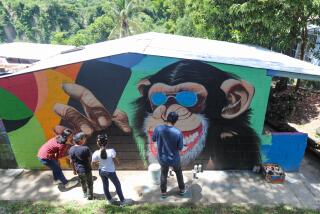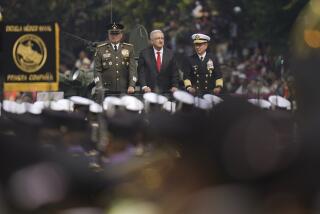El Salvador becomes drug traffickers’ ‘little pathway’
Reporting from Dulce Nombre de Maria, El Salvador — The Mexican drug gangs rapidly infiltrating Central America call El Salvador “El Caminito,” the little pathway.
Once a bystander in the region’s narco-business, this tiny country now finds itself enmeshed in an expanding drug trade, a shift brought on in part by the presence of a new, U.S.-funded highway that provides an overland route for shipping cocaine north.
For years, traffickers used speedboats and small submarine-type vessels to move drugs from Colombia to northern Guatemala or Mexico, using water routes to circumvent much of Central America. But with government sea patrols improving and new cartels creating competition in parts of Guatemala, some Mexican gangs have switched to moving their shipments overland through Central America, using the new roadway through El Salvador.
The cartels’ infiltration of the country has been abetted by ruthless street gangs with roots in Los Angeles and secretive networks left over from El Salvador’s civil war. And with its use of the U.S. dollar as its official currency, the nation is a money launderer’s paradise.
Those conditions have turned a country still struggling to emerge from the nightmare of a long civil war into a new setting for the Mexican drug cartels’ violent turf wars. When President Obama arrives here Tuesday for talks with Salvadoran President Mauricio Funes, the regional struggle with security and organized crime will be a focus of their discussions.
“Mexican organized crime is a threat in all of Central America,” the Salvadoran attorney general, Romeo Barahona, said after meeting with his counterparts in Mexico to share intelligence on the mounting crisis.
Weak institutions and corrupt governments made Central America a fertile field, especially for the ruthless Zetas gang, a Mexican paramilitary organization that has spread throughout the region and into the U.S.
The Zetas have taken charge of much of the Guatemalan countryside, and hundreds of people have been killed there, in Honduras and in El Salvador in the last six months. The government of Guatemala declared a state of emergency Dec. 19 in northern Alta Verapaz province bordering Mexico, and deployed the army in a bid to retake cities lost to the Zetas.
In Honduras, officials this month discovered a cocaine laboratory, possibly the first evidence that Mexican traffickers are making their own cocaine after years of Colombian monopoly. Even the placid, tourist-mecca country of Costa Rica is complaining that Mexican traffickers are setting up shop.
And here in El Salvador, authorities stumbled upon what they believe to be a Zetas training camp and recently dug up more than $15 million in drug money, buried in plastic barrels and thought to be but a fraction of hidden cash.
President Funes recently told The Times that Zetas were working in his country. Defense Minister David Munguia underscored that, saying the Zetas and other Mexican traffickers were “moving their strategic rear guard to Central America.”
Mexican traffickers in El Salvador have been able to easily graft onto existing criminal organizations, most notably street gangs that were born in Los Angeles and deported to El Salvador during the last two decades — and that now dominate neighborhoods in most Salvadoran cities.
Also, networks built on both sides during El Salvador’s civil war that morphed into smuggling operations have proved a godsend to Mexican cartels. One group, Los Perrones (“the big dogs”), smuggled cheap Honduran cheese into El Salvador for years until shifting to drugs. Another sent dozens of its members to be trained by the Zetas in Guatemala.
More than 60% of all cocaine that reaches the U.S. now passes through Central America, according to the State Department.
With the sea routes more problematic for traffickers, some gangs have shifted an important part of their transport operation to land routes through Central America, including the path across northern El Salvador.
It is a process of more, smaller shipments that “leapfrog” along the route, law enforcement officials say. Cargo comes in from Honduras and is offloaded and repackaged near Dulce Nombre de Maria, in El Salvador’s northern Chalatenango province, then trucked across Chalatenango and Santa Ana provinces to Guatemala, virtually unhindered.
Police and intelligence sources say several businessmen and mayors are on the traffickers’ payroll and serve as their money launderers. Dulce Nombre de Maria, once a sleepy, dusty town, is now a sparkling burg. The gazebo in the main square is painted in salmon and lavender and decorated with Corinthian columns. Grounds are well manicured, free of beggars and stray dogs. The ice cream vendor wears Ralph Lauren.
And in the realm of unintended consequences, the traffickers are benefiting from the U.S.-financed construction of a major roadway across northern El Salvador. It’s part of a $461-million project sponsored by Millennium Challenge Corp., a U.S. government initiative to spur development in poor countries. The new highway widens to three or four lanes in places as it slices through steep hills that were arduous to cross during the civil war. Engineers are still working on steep retaining walls and terraced banks.
Law enforcement officials say the exorbitant drug profits flow mostly to the same small group of businessmen and political elite who have always controlled this and other Central American nations.
Like Mexico and Guatemala before it, El Salvador has witnessed the way drug money corrupts institutions, including the police and military, and the highest levels of government.
Capt. Hector Guillen was a ranking officer in the Salvadoran army’s elite special forces. He had access to enormous supplies of military-grade weaponry, much of it, like one cache of half a million U.S.-supplied grenades and shoulder-fired surface-to-air missiles, left over from the war. In November, just outside Washington, he allegedly offered to trade 3,000 assault rifles, 20 pounds of C-4 plastic explosives and scores of grenades for drugs and money to people he thought were representing leftist Colombian guerrillas.
Instead, Guillen, 32, was trapped in a sting operation by the U.S. Drug Enforcement Administration. He was arrested and last month indicted by a U.S. federal grand jury on charges of attempting to provide material support to what Washington has designated as a terrorist organization, the Revolutionary Armed Forces of Colombia, or FARC. A trial was set for May.
It was the most significant case yet in establishing the depths of drug corruption in the Salvadoran military and might have reached higher levels had a press leak not shut down the investigation.
In another case, Salvadoran intelligence officials have identified 16 police and 10 military officers they suspect of working with an L.A.-born gangster known as El Burro, who has also affiliated himself with the Zetas. He controls much of the trafficking through western El Salvador and has laundered his money through hotels, resorts and car washes, the officials allege.
Mexican drug traffickers first made inroads in El Salvador with the Mara Salvatrucha, the country’s oldest and most receptive gang, eager to hire itself out. The other major group, the 18th Street gang, was more suspicious of the Mexicans and resisted outside pressure until early this year, according to Salvadoran intelligence sources.
An attack on a passenger bus last month in which seven people were killed may have been an initiation test for the 18th Street gangsters to prove themselves to the Zetas, the sources said. Salvadoran gangs also have started delivering unsuspecting immigrants trying to cross into the United States into the waiting hands of Zetas, who then try to extort money from the victims’ families upon pain of death.
Police say they recently discovered what they believe to be a Zetas training ground hidden in coffee fields on the edge of the Guazapa volcano, which dominates San Salvador’s skyline.
Few discoveries, however, could match the plastic barrels discovered last fall buried on properties that authorities have tied to Jorge Mario Paredes-Cordova, who was convicted in the United States in April on drug charges and sentenced to 31 years in prison. The U.S. federal attorney handling the case described the Guatemalan as one of the world’s most dangerous drug traffickers.
Paredes-Cordova liked to visit El Salvador and, apparently, thought it a good place to hide some of his millions. His numerous houses were full of trap doors and walls that moved with the touch of a button to reveal secret compartments, according to people who inspected the properties.
On an unoccupied farm, authorities acting on DEA intelligence discovered plastic water barrels with $100 bills and 500-euro notes — more than $10 million in cash.
More to Read
Sign up for Essential California
The most important California stories and recommendations in your inbox every morning.
You may occasionally receive promotional content from the Los Angeles Times.











